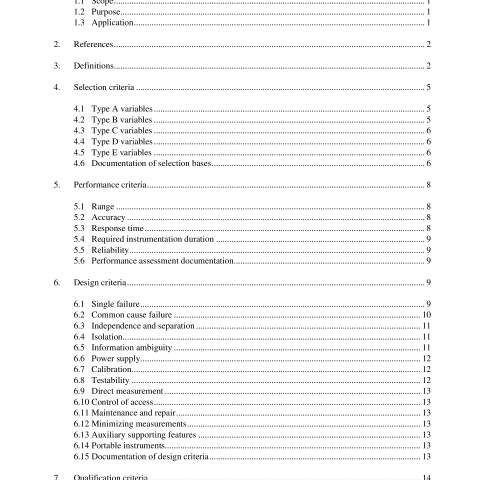IEEE 497-2010 pdf download.IEEE Standard Criteria for Accident Monitoring Instrumentation for Nuclear Power Generating Stations
3.15 licensing basis documentation (LBD): The set of U.S. Nuclear Regulatory Commission (NRC) requirements applicable to a specific plant and a licensee’s written commitments for ensuring compliance with and operation within applicable NRC requirements and the plant specific licensing basis (including all modifications and additions to such commitments over the life of the license) that are documented and in effect (see Title 10 CFR, Part 54 [B11]).
The LBD consists of:
— The latest version of the Final Safety Analysis Report (FSAR), the Updated Safety Analysis Report (USAR), or the Standard Safety Analysis Report (SSAR)
— NRC Safety Evaluation Reports
— Operating License, Final Design Certification, including the Technical Specifications, and
— Correspondence between the NRC and the licensee that contains licensing requirements or commitments for the design or operation of the nuclear power plant or standard plant design.
3.16 precision: The degree of mutual agreement between individual measurements, namely repeatability and reproducibility.
3.17 processing segment: The electrical components or modules in an information display channel that receive the sensing segment outputs and perform various conversions and compensation on the sensed signal.
The processing electronics may include sensor power supply, analog-to-digital (A/D) conversion, signal compensation, electrical to engineering unit conversion, digital-to-analog (D/A) conversion, and electrical isolation devices for signal interfacing between safety systems and other systems (see Figure 1).
3.18 rate: The first time derivative of the current value.
3.19 response time: The time required for the output to reach 90 percent of the final output value in response to a step input.
3.20 safety-related function: A function that is relied upon during or following design basis events to ensure: the integrity of the reactor coolant pressure boundary; the capability to shut down the reactor and maintain it in a safe shutdown condition, and (the capability to prevent or mitigate the consequences of accidents that could result in potential off-site exposures comparable to Title 10 CFR Part 100 guidelines [B9])
3.21 safety system: A system relied upon to remain functional during and following design basis events to ensure: the integrity of the reactor coolant pressure boundary; the capability to shut down the reactor and maintain it in a safe shutdown condition, or the capability to prevent or mitigate the consequences of accidents that could result in potential off-site exposures comparable to Title 10 CFR Part 100 guidelines [B9].
3.22 sense and command feature: The electrical and mechanical components and interconnections involved in generating those signals associated directly or indirectly with the safety functions. The scope of the sense and command features extends from the measured process variables to the execute features input terminals.
3.23 sensing segment: The electrical and mechanical components or modules in an information display channel from measured process variable to the input of the processing electronics (see Figure 1).
4. Selection criteria
This clause provides criteria for identifying the plant specific variables for accident monitoring. The variable types will be referred to as A, B, C, D, and E. Criteria for the selection of each type of variable are given below and summarized in Table 1.
4.1 Type A variables Type A variables are those variables that provide the primary information required to permit the control room operating staff to:
a) Take specific planned manually-controlled actions for which no automatic control is provided and that are required for safety systems to perform their safety-related functions as assumed in the plant Accident Analysis Licensing Basis.
b) Take specific planned manually-controlled actions for which no automatic control is provided and that are required to mitigate the consequences of an AOO. Type A variables provide information essential for the direct accomplishment of specific safety-related functions that require manual action.
These variables are a subset of those necessary to implement the plant specific emergency procedure guidelines (EPGs) or the plant specific emergency operating procedures (EOPs) or the plant abnormal operating procedures (AOPs).
Type A variables do not include those variables that are associated with contingency actions that may also be identified in written procedures.
4.2 Type B variables Type B variables are those variables that provide primary information to the control room operators to assess the plant critical safety functions. Any plant critical safety functions addressed in the EPGs or the plant specific EOPs that are in addition to those identified above shall also be included.IEEE 497 pdf download.IEEE 497-2010 pdf download
IEEE 497-2010 pdf download

Leave a Reply